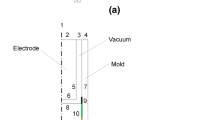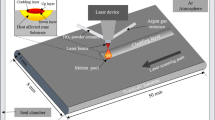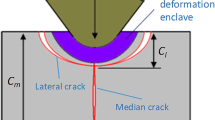Abstract
A high-current monopulse electrical discharge machining (EDM) discharge ablation technique (i.e., monopulse EDM ablation) to drill Ti-6Al-4V titanium alloy plates is proposed. The activated surface material that employs discharge energy as induced energy induces a dramatic combustion reaction with oxygen. Perforation under the monopulse discharge effect is achieved depending on ablation energy produced by the metal oxidation reaction. A system with a monopulse generator is established to perform a monopulse EDM ablation drilling experiment on Ti-6Al-4V titanium alloy. The mechanism is analyzed. Mechanism analysis indicates that the process of monopulse EDM ablation drilling generally has five stages, namely, monopulse discharge and formation of the activated area, violent oxidation of the discharge point, oxidation hindered by the oxide layer, transmissible ablation extension, and downward ablation layer by layer. Tests of via holes are performed to compare EDM drilling and monopulse EDM ablation drilling. Results show that perforation is achieved at 500 μs by monopulse EDM ablation drilling for a 10-mm thick titanium alloy plate. However, the machining efficiency of EDM drilling is low (the machining time is 160 s) and cannot meet the value required by high-efficiency machining. The technology can be applied to cutting Ti-6Al-4V titanium alloy plates.
Similar content being viewed by others
References
Ezugwu EO, Wang ZM (1997) Titanium alloys and their machinability—a review. J Mater Process Technol 68(3):262–274
Lian F, Zhang HC (2012) The latest research on processing technology of titanium alloy by EDM. Mod Manuf Eng 2:18–23
Norliana MA, Solomon DG, Bahari MF (2007) A review on current research trends in electrical discharge machining (EDM). Int J Mach Tool Manu 47(7–8):1214–1228
Aliakbari E, Baseri H (2012) Optimization of machining parameters in rotary EDM process by using the Taguchi method. Int J Adv Manuf Technol 62(9–12):1041–1053
Tiwary AP, Pradhan BB, Bhattacharyya B (2015) Study on the influence of micro-EDM process parameters during machining of Ti–6Al–4V superalloy. Int J Adv Manuf Technol 76(1–4):151–160
Jabbaripour B, Sadeghi MH, Faridvand SH, Shabgard MR (2012) Investigating the effects of EDM parameters on surface integrity MRR and TWR in machining of Ti-6Al-4V. Mach Sci Technol 16:419–444
Wang XZ, Liu ZD, Xue RY, Tian ZJ, Huang YH (2013) Research on self-mixed oxygen in discharge gap to improve the processing characteristics of titanium alloy electrical discharge machining. Acta Aeronaut Astronaut Sin 34:2419–2426
Liu ZD (2012) Series typical efficient machining methods of controllable burning by discharge-induced. Electromachin Mould 1:1–5
Cao ZL, Liu ZD, Ling JJ, Qiu MB, Wang XZ (2015) Deep-type hole machining by inner jetted aerosol dielectric ablation. Int J Adv Manuf Technol 78(9-12):1989–1998
Borisova EA, Sklyarov NM (1993) Fireproof titanium alloys. In: Physical metallurgy. New Alloys pp 21–24
Bolobov VI (2002) Mechanism of self-ignition of titanium alloys in oxygen. Combust Explo Shock 38(6):639–645
Lee LC, Lim LC, Narayanan V, Venkatesh VC (1988) Quantification of surface damage of tool steels after EDM. Int J Mach Tool Manu 4:359–372
Wang XZ, Liu ZD, Qiu MB, Hui ZG, Tian ZJ, Huang YH (2014) Mechanism of electrical discharge machining ablation. Mater Manuf Process 29(11–12):1367–1373
Huang MY (2013) Research on burning characteristics of aircraft engine titanium alloys. Xi’an University of Architecture and Technology, Xi’an, People’s Republic of China
Huang C, Zhang YZ, Shen JY, Vilar R (2011) Thermal stability and oxidation resistance of laser clad TiVCrAISi high entropy alloy coatings on Ti-6A1-4V alloy. Surf Coat Technol 206:1389–1395
Huang X, Zhou YH (1997) Titanium combustion in aeroengines and fire-resistant titanium alloys. J Mater Eng 8:11–15
Hu JS, Zheng KL (2005) Solving Bernoulli equation by integrating factor method. J Sichuan Univ Sci Eng 18(3):86–87
Bird GA (1976) Molecular gas dynamics. Clarendon, Oxford
Li MH (1989) Theoretical basis of EDM. National Defense Industry Press, Beijing
Author information
Authors and Affiliations
Corresponding author
Rights and permissions
About this article
Cite this article
Cao, Z., Liu, Z., Wang, X. et al. Monopulse electrical discharge machining ablation drilling technology for Ti-6Al-4V titanium alloy. Int J Adv Manuf Technol 86, 539–546 (2016). https://doi.org/10.1007/s00170-015-8169-9
Received:
Accepted:
Published:
Issue Date:
DOI: https://doi.org/10.1007/s00170-015-8169-9




